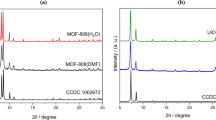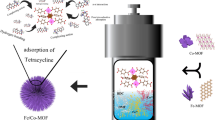Abstract
Ferulic acid (FA) is a natural antioxidant with limited absorption when conjugated with biomolecules but whose free form is readily absorbed in the stomach and, to a lesser extent, in the ileum. The latter suffers from inflammation and oxidative stress, so a novel strategy for the delivery of FA in this compartment of the gastrointestinal tract was developed. Using the neutral un-functionalized resin Lewatit® VP OC 1064 MD PH, under optimized conditions, a loading of 144 mg FA/g of dry resin was obtained. By means of an in vitro simulated digestion, an average release of 32 mg FA/g of dry loaded resin (recovery of 22%) was observed in intestinal conditions. The incorporation/release of FA onto/from the resin was confirmed by ATR-FTIR spectroscopy and by HPLC-DAD. This work showed that the free form of FA can effectively be delivered in the small intestine, after immobilization in solid matrices.





Similar content being viewed by others
Abbreviations
- ATR-FTIR:
-
Attenuated total reflectance-Fourier transform infrared
- C0 :
-
Initial concentration
- CA:
-
Caffeic acid
- Ce :
-
Concentration at equilibrium
- ChA:
-
5-O-Caffeoylquinic acid
- Cr :
-
Concentration of released ferulic acid
- FA:
-
Ferulic acid
- GI:
-
Gastrointestinal
- HCA(s):
-
Hydroxycinnamic acid(s)
- HPLC-DAD:
-
High-performance liquid chromatography with diode-array detection
- Lewatit:
-
Lewatit® VP OC 1064 MD PH
- m :
-
Mass of resin
- pCA:
-
p-Coumaric acid
- q e :
-
Amount of compound adsorbed for unit mass of adsorbent
- q r :
-
Amount of ferulic acid released from the resin
- SA:
-
Sinapic acid
- V :
-
Volume of solution
- V r :
-
Volume of simulated medium
References
El-Seedi HR, El-Said AMA, Khalifa SAM et al (2012) Biosynthesis, natural sources, dietary intake, pharmacokinetic properties, and biological activities of hydroxycinnamic acids. J Agric Food Chem 60:10877–10895. https://doi.org/10.1021/jf301807g
Zhao Z, Moghadasian MH (2008) Chemistry, natural sources, dietary intake and pharmacokinetic properties of ferulic acid: a review. Food Chem 109:691–702. https://doi.org/10.1016/j.foodchem.2008.02.039
Graf E (1992) Antioxidant potential of ferulic acid. Free Radic Biol Med 13:435–448. https://doi.org/10.1016/0891-5849(92)90184-I
Itagaki S, Kurokawa T, Nakata C et al (2009) In vitro and in vivo antioxidant properties of ferulic acid: a comparative study with other natural oxidation inhibitors. Food Chem 114:466–471. https://doi.org/10.1016/j.foodchem.2008.09.073
Bumrungpert A, Lilitchan S, Tuntipopipat S et al (2018) Ferulic acid supplementation improves lipid profiles, oxidative stress, and inflammatory status in hyperlipidemic subjects: a randomized, double-blind, placebo-controlled clinical trial. Nutrients 10:6–13. https://doi.org/10.3390/nu10060713
Chowdhury S, Ghosh S, Das AK, Sil PC (2019) Ferulic acid protects hyperglycemia-induced kidney damage by regulating oxidative insult, inflammation and autophagy. Front Pharmacol 10:1–24. https://doi.org/10.3389/fphar.2019.00027
Ghosh S, Basak P, Dutta S et al (2017) New insights into the ameliorative effects of ferulic acid in pathophysiological conditions. Food Chem Toxicol 103:41–55. https://doi.org/10.1016/j.fct.2017.02.028
Mancuso C, Santangelo R (2014) Ferulic acid: pharmacological and toxicological aspects. Food Chem Toxicol 65:185–195. https://doi.org/10.1016/j.fct.2013.12.024
Sadar SS, Vyawahare NS, Bodhankar SL (2016) Ferulic acid ameliorates TNBS-induced ulcerative colitis through modulation of cytokines, oxidative stress, inos, cox-2, and apoptosis in laboratory rats. EXCLI J 15:482–499. https://doi.org/10.17179/excli2016-393
Dong W-G, Liu S-P, Yu B-P et al (2003) Ameliorative effects of sodium ferulate on experimental colitis and their mechanisms in rats. World J Gastroenterol 9:2533–2538. https://doi.org/10.3748/wjg.v9.i11.2533
Kandhare AD, Patil A, Guru A et al (2016) Ameliorative effect of ferulic acid against acetic acid induced ulcerative colitis: role of HO-1 and Nrf2. Pharmacologia 7:114–124. https://doi.org/10.5567/pharmacologia.2016.114.124
Adam A, Crespy V, Levrat-Verny M-A et al (2002) The bioavailability of ferulic acid is governed primarily by the food matrix rather than its metabolism in intestine and liver in rats. J Nutr 132:1962–1968. https://doi.org/10.1093/jn/132.7.1962
Zhao Z, Egashira Y, Sanada H (2003) Digestion and absorption of ferulic acid sugar esters in rat gastrointestinal tract. J Agric Food Chem 51:5534–5539. https://doi.org/10.1021/jf034455u
Anson NM, van den Berg R, Havenaar R et al (2009) Bioavailability of ferulic acid is determined by its bioaccessibility. J Cereal Sci 49:296–300. https://doi.org/10.1016/j.jcs.2008.12.001
Manach C, Scalbert A, Morand C et al (2004) Polyphenols: food sources and bioavailability. Am J Clin Nutr 79:727–747. https://doi.org/10.1093/ajcn/79.5.727
Lafay S, Gil-Izquierdo A (2008) Bioavailability of phenolic acids. Phytochem Rev 7:301–311. https://doi.org/10.1007/s11101-007-9077-x
Zhao Z, Egashira Y, Sanada H (2004) Ferulic acid is quickly absorbed from rat stomach as the free form and then conjugated mainly in liver. J Nutr 134:3083–3088. https://doi.org/10.1093/jn/134.11.3083
Donovan JL, Manach C, Faulks RM, Kroon PA (2006) Absorption and metabolism of dietary plant secondary metabolites. In: Crozier A, Clifford MN, Ashihara H (eds) Plant secondary metabolites—occurrence, structure and role in the human diet. Blackwell Publishing Ltd, Oxford, pp 303–351
Malunga LN, Beta T (2016) Isolation and identification of feruloylated arabinoxylan mono- and oligosaccharides from undigested and digested maize and wheat. Heliyon. https://doi.org/10.1016/j.heliyon.2016.e00106
Anselmi C, Centini M, Maggiore M et al (2008) Non-covalent inclusion of ferulic acid with α-cyclodextrin improves photo-stability and delivery: NMR and modeling studies. J Pharm Biomed Anal 46:645–652. https://doi.org/10.1016/j.jpba.2007.11.037
Carlotti ME, Sapino S, Ugazio E et al (2008) Photostability of ferulic acid and its antioxidant activity against linoleic acid peroxidation. J Dispers Sci Technol 29:629–640. https://doi.org/10.1080/01932690701757766
Aceituno-Medina M, Mendoza S, Rodríguez BA et al (2015) Improved antioxidant capacity of quercetin and ferulic acid during in-vitro digestion through encapsulation within food-grade electrospun fibers. J Funct Foods 12:332–341. https://doi.org/10.1016/j.jff.2014.11.028
Yu D-G, Yang J-M, Branford-White C et al (2010) Third generation solid dispersions of ferulic acid in electrospun composite nanofibers. Int J Pharm 400:158–164. https://doi.org/10.1016/j.ijpharm.2010.08.010
Dávila-Guzman NE, Cerino-Córdova FJ, Diaz-Flores PE et al (2012) Equilibrium and kinetic studies of ferulic acid adsorption by amberlite XAD-16. Chem Eng J 183:112–116. https://doi.org/10.1016/j.cej.2011.12.037
Yang Q, Zhao M, Lin L (2016) Adsorption and desorption characteristics of Adlay bran free phenolics on macroporous resins. Food Chem 194:900–907. https://doi.org/10.1016/j.foodchem.2015.08.070
Kammerer J, Schweizer C, Carle R, Kammerer DR (2011) Recovery and fractionation of major apple and grape polyphenols from model solutions and crude plant extracts using ion exchange and adsorbent resins. Int J Food Sci Technol 46:1755–1767. https://doi.org/10.1111/j.1365-2621.2011.02681.x
Simon V, Thuret A, Candy L et al (2015) Recovery of hydroxycinnamic acids from renewable resources by adsorption on zeolites. Chem Eng J 280:748–754. https://doi.org/10.1016/j.cej.2015.06.009
LANXESS (2011) Product information Lewatit® VP OC 1064 MD PH. https://www.lenntech.com/Data-sheets/Lewatit-VP-OC-1064-MD-PH-L.pdf
Conidi C, Rodriguez-Lopez AD, Garcia-Castello EM, Cassano A (2015) Purification of artichoke polyphenols by using membrane filtration and polymeric resins. Sep Purif Technol 144:153–161. https://doi.org/10.1016/j.seppur.2015.02.025
Pinto J, Spínola V, Llorent-Martínez EJ et al (2017) Polyphenolic profile and antioxidant activities of Madeiran elderberry (Sambucus lanceolata) as affected by simulated in vitro digestion. Food Res Int 100(3):404–410. https://doi.org/10.1016/j.foodres.2017.03.044
Flores FP, Singh RK, Kerr WL et al (2014) Total phenolics content and antioxidant capacities of microencapsulated blueberry anthocyanins during in vitro digestion. Food Chem 153:272–278. https://doi.org/10.1016/j.foodchem.2013.12.063
Egawa H, Yorifuji T, Sumazaki R et al (2002) Intractable diarrhea after liver transplantation for Byler’s disease: successful treatment with bile adsorptive resin. Liver Transpl 8:714–716. https://doi.org/10.1053/jlts.2002.34384
Guo X, Chang R, Hussain MA (2009) Ion-exchange resins as drug delivery carriers. J Pharm Sci 98:3886–3902. https://doi.org/10.1002/jps.21706
Shahidi F, Chandrasekara A (2015) The use of antioxidants in the preservation of cereals and low-moisture foods. In: Shadini F (ed) Handbook of antioxidants for food preservation. Woodhead Publishing, Cambridge, pp 413–432
Kammerer DR, Saleh ZS, Carle R, Stanley RA (2007) Adsorptive recovery of phenolic compounds from apple juice. Eur Food Res Technol 224:605–613. https://doi.org/10.1007/s00217-006-0346-5
Geerkens CH, Matejka AE, Schweiggert RM et al (2015) Optimization of polyphenol recovery from mango peel extracts by assessing food-grade adsorbent and ion exchange resins and adsorption parameters using a D-optimal design. Eur Food Res Technol 241:627–636. https://doi.org/10.1007/s00217-015-2489-8
Kammerer D, Gajdos Kljusuric J, Carle R, Schieber A (2005) Recovery of anthocyanins from grape pomace extracts (Vitis vinifera L. cv. Cabernet Mitos) using a polymeric adsorber resin. Eur Food Res Technol 220:431–437. https://doi.org/10.1007/s00217-004-1078-z
Chang X-L, Wang D, Chen B-Y et al (2012) Adsorption and desorption properties of macroporous resins for anthocyanins from the calyx extract of Roselle (Hibiscus sabdariffa L.). J Agric Food Chem 60:2368–2376. https://doi.org/10.1021/jf205311v
Erfurt H, Schuld R, Stürtz M et al. (2014) Antioxidant composition
Casas MP, Soto ML, Díaz-Reinoso B et al (2017) Purification of polyphenol extracts from natural sources—adsorption and membrane technologies. In: Cuevas-Valenzuela J, Vergara-Salinas JR, Pérez-Correa JR (eds) Advances in technologies for producing food-relevant polyphenols. CRC Press, Taylor & Francis, Boca Raton, pp 221–259
Dhal PK, Huval CC, Holmes-Farley SR (2006) Polymeric sequestrants as nonabsorbed human therapeutics. In: Chorghade MS (ed) Drug discovery and development drug discovery, vol 1. Wiley, Hoboken, pp 383–404
Charlton-Menys V, Durrington PN (2008) Human cholesterol metabolism and therapeutic molecules. Exp Physiol 93:27–42. https://doi.org/10.1113/expphysiol.2006.035147
Acknowledgements
The authors acknowledge LANXESS, Germany, for providing the resin Lewatit® VP OC 1064 MD PH. David Quintal is also acknowledged for the artwork. This work was part of the master’s dissertation of G.N.M.
Funding
This study was funded by Fundação para a Ciência e a Tecnologia (CQM Project PEstOE/QUI/UI0674/2019, Portuguese Government funds, by Madeira 14–20 Program, project PROEQUIPRAM—Reforço do Investimento em Equipamentos e Infraestruturas Científicas na RAM (M1420-01–0145-FEDER-000008) and by ARDITI-Agência Regional para o Desenvolvimento da Investigação Tecnologia e Inovação, through the project M1420-01–0145-FEDER-000005—Centro de Química da Madeira—CQM + (Madeira 14–20 Program).
Author information
Authors and Affiliations
Contributions
GNM did the experimental work. VS helped with the chromatographic analyses and with the gastrointestinal digestion simulation, statistical analysis, and manuscript revision. GNM and PCC contributed for the analysis and discussion of results and writing of the manuscript. PCC coordinated the work and did the final revision of the manuscript. All authors have approved the final version of the manuscript.
Corresponding author
Ethics declarations
Conflict of interests
The authors declare no conflict of interest.
Compliance with ethics requirements
No ethical issues derive from this work.
Additional information
Publisher's Note
Springer Nature remains neutral with regard to jurisdictional claims in published maps and institutional affiliations.
Electronic supplementary material
Below is the link to the electronic supplementary material.
Rights and permissions
About this article
Cite this article
Martins, G.N., Spínola, V. & Castilho, P.C. Release of adsorbed ferulic acid in simulated gastrointestinal conditions. Eur Food Res Technol 246, 1297–1306 (2020). https://doi.org/10.1007/s00217-020-03489-w
Received:
Revised:
Accepted:
Published:
Issue Date:
DOI: https://doi.org/10.1007/s00217-020-03489-w




